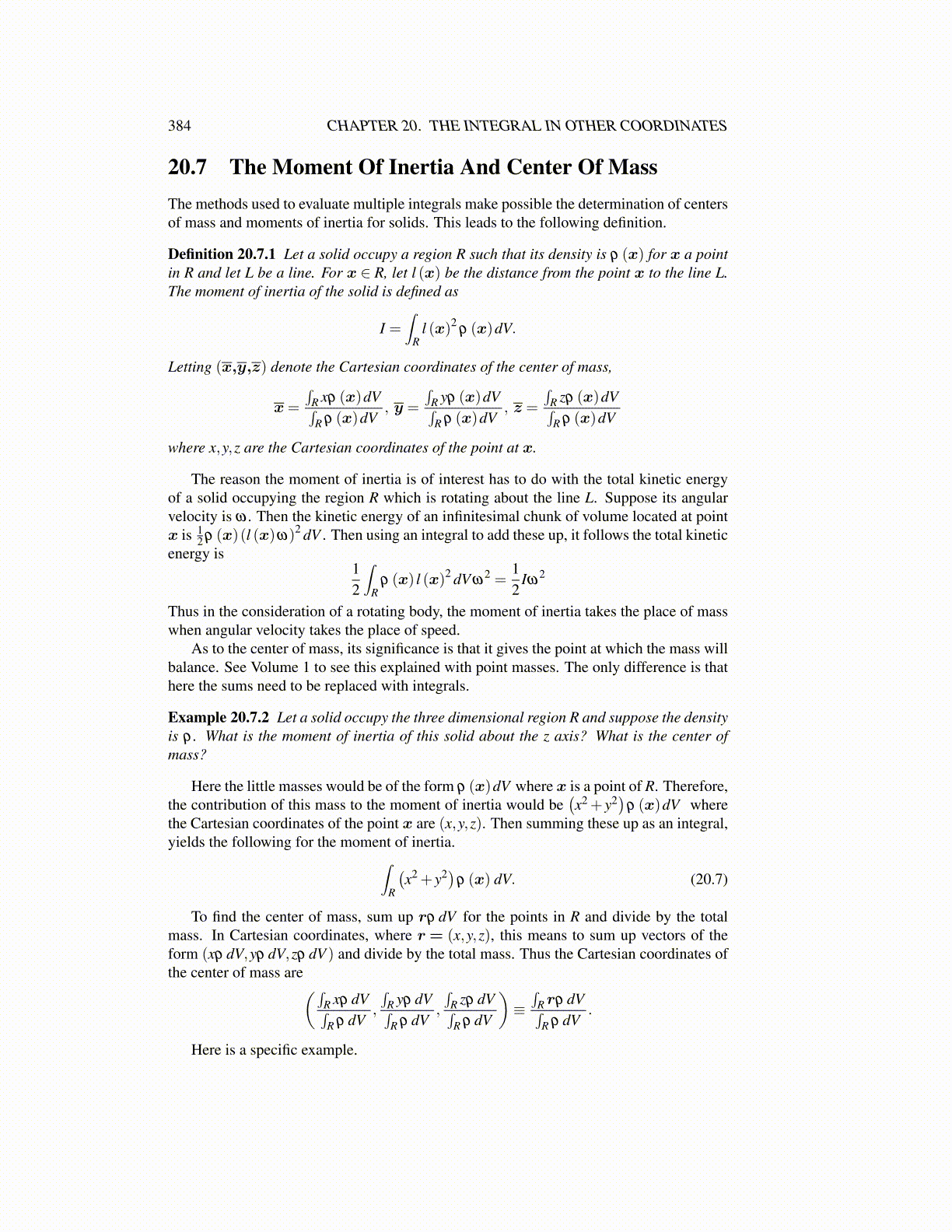
384 CHAPTER 20. THE INTEGRAL IN OTHER COORDINATES
20.7 The Moment Of Inertia And Center Of MassThe methods used to evaluate multiple integrals make possible the determination of centersof mass and moments of inertia for solids. This leads to the following definition.
Definition 20.7.1 Let a solid occupy a region R such that its density is ρ (x) for x a pointin R and let L be a line. For x ∈ R, let l (x) be the distance from the point x to the line L.The moment of inertia of the solid is defined as
I =∫
Rl (x)2
ρ (x)dV.
Letting (x,y,z) denote the Cartesian coordinates of the center of mass,
x=
∫R xρ (x)dV∫R ρ (x)dV
, y =
∫R yρ (x)dV∫R ρ (x)dV
, z =
∫R zρ (x)dV∫R ρ (x)dV
where x,y,z are the Cartesian coordinates of the point at x.
The reason the moment of inertia is of interest has to do with the total kinetic energyof a solid occupying the region R which is rotating about the line L. Suppose its angularvelocity is ω . Then the kinetic energy of an infinitesimal chunk of volume located at pointx is 1
2 ρ (x)(l (x)ω)2 dV . Then using an integral to add these up, it follows the total kineticenergy is
12
∫R
ρ (x) l (x)2 dV ω2 =
12
Iω2
Thus in the consideration of a rotating body, the moment of inertia takes the place of masswhen angular velocity takes the place of speed.
As to the center of mass, its significance is that it gives the point at which the mass willbalance. See Volume 1 to see this explained with point masses. The only difference is thathere the sums need to be replaced with integrals.
Example 20.7.2 Let a solid occupy the three dimensional region R and suppose the densityis ρ . What is the moment of inertia of this solid about the z axis? What is the center ofmass?
Here the little masses would be of the form ρ (x)dV where x is a point of R. Therefore,the contribution of this mass to the moment of inertia would be
(x2 + y2
)ρ (x)dV where
the Cartesian coordinates of the point x are (x,y,z). Then summing these up as an integral,yields the following for the moment of inertia.∫
R
(x2 + y2)
ρ (x) dV. (20.7)
To find the center of mass, sum up rρ dV for the points in R and divide by the totalmass. In Cartesian coordinates, where r = (x,y,z), this means to sum up vectors of theform (xρ dV,yρ dV,zρ dV ) and divide by the total mass. Thus the Cartesian coordinates ofthe center of mass are(∫
R xρ dV∫R ρ dV
,
∫R yρ dV∫R ρ dV
,
∫R zρ dV∫R ρ dV
)≡∫
R rρ dV∫R ρ dV
.
Here is a specific example.